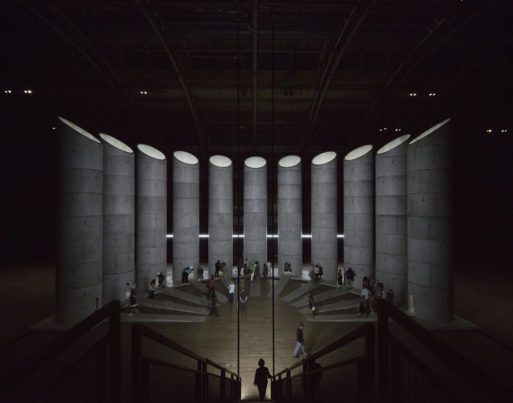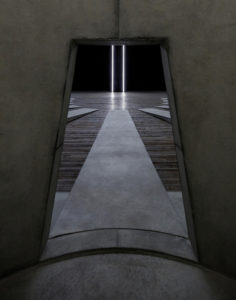
Credit: oma.eu
Conceptual visual art can be a beautiful medium, especially when the artist uses elements of architecture in the design. However, Taryn Simon’s work “An Occupation of Loss” is so much more than just a lovely structure to behold. Simon uses both visuals and sound to completely engross her audience, capturing nearly every sense in a single piece of performance art. The result is a conceptual work of art that is surreal and intellectual, yet that still creates a strong emotional connection with those who witness it. It’s high-concept art with soul.
“An Occupation of Loss” was installed in the Park Avenue Armory in New York in 2016. The structure consists of 11 hollow concrete towers built next to one another in a semicircle. The enormous concrete tubes, which resemble open-roofed grain silos, are an incredible 48 feet tall; they absolutely loom over those who walk into the space.
This intimidating wall of grey silos would have been interesting enough on its own, but Taryn Simon wanted her work to resonate with people on a deeply emotional level. To accomplish this, she had each concrete tower specifically designed to carry sound through the cavernous Park Avenue Armory.
To surround the space with as much sound as possible, Simon collaborated with famed architect Shohei Shigematsu. The architect took inspiration from Zoroastrian “Tower of Silence.” Zoroastrianism is an ancient religion founded near modern day India and Iran, and those who followed the religion were thought to have placed their dead inside of open-roofed circular towers, which allowed carrion birds to access the tombs from above.

Credit: oma.eu
Using the towers of silence as a blueprint, Shigematsu built each of the towers inside of Park Avenue Armory’s Drill Hall. Once construction was complete, Taryn Simon then hired 30 professional mourners from different cultural backgrounds to create sounds that best represented their own methods of grieving. Some mourners played music on traditional instruments. Others sang traditional funeral songs. Many prayed or spoke words of comfort from religious texts. And some mourners simply cried.
To put all of these components together, Simon held a special performance every night in the armory from September 13 through September 25, 2016. During the performances, the mourners would step inside of their respective towers and begin creating their sounds of choice. As the sound traveled from the base of each tower to its open roof, the noises quickly enveloped the space, just like organ pipes.
The visual power of the hollow towers, combined with the sounds of people mourning, create a full experience for the audience. Those witnessing the performance are surrounded by grief both literally and figuratively. They can hear it in the mourners’ voices; they can touch the cold, grey towers; they can see the enormity of the structure and feel rather small and fragile by comparison.

Credit: oma.eu
What makes “An Occupation of Loss” so unique is that the lines between the art and the audience are blurred. During the day, people can walk through the space and even stand inside of the towers themselves. They can interact with the art firsthand. At night, when the actual performance begins, they can see and hear others expressing their grief, and appreciate the fact that we all grieve slightly differently, and yet we are deeply connected by the same powerful emotions that follow a loss.
“An Occupation of Loss” serves as one of the few examples of communal grieving in Western society. It’s not common to find spaces where people from different families, cultures and religions can come together to grieve. Outward expressions of grief are often seen as a personal, intimate moment that should be kept behind closed doors. To not only express these emotions in a public space, but also amplify them using specially-designed sound towers, Simon makes a powerful statement about how we deal with loss in the United States. She shows us a beautiful alternative to bottled-up, silent grief–that there is comfort and support in communities and open emotional expression.

 Taryn Simon Marries Architecture to Sound in “An Occupation of Loss”
Taryn Simon Marries Architecture to Sound in “An Occupation of Loss”


 John Mulaney’s “Funeral Planning” on Netflix: No Real Plan
John Mulaney’s “Funeral Planning” on Netflix: No Real Plan

 Composting Bodies Is Now Legal in a Dozen States
Composting Bodies Is Now Legal in a Dozen States














